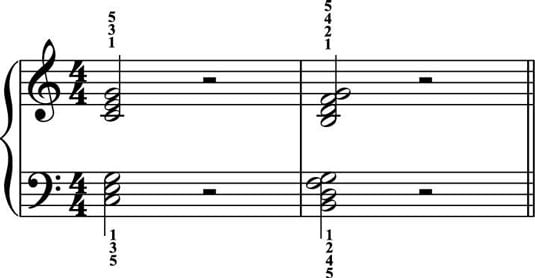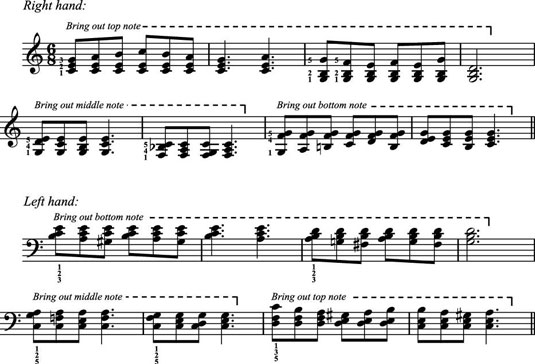Chord playing is one of the greatest pleasures — and biggest advantages — of playing the piano. The piano sounds the best when you make the most of its full harmonic potential.
To get your piano to really sing out, you need flexibility in the wrist to increase your attack speed when you play chords. To balance, or voice, the chord notes, you need control in your fingers to vary the quality of your touch.
Naturally, you want to dig into the big chords and get your hands around the really fat harmonies, but keeping stiff fingers and awkward hand positions is tiring and can potentially cause some physical problems. Avoiding these problems and improving your chord voicing are the benefits of learning how to relieve the tension in your fingers, hands, and arms.
These exercises help you learn to play chords with a relaxed approach, gain a better chord technique, and improve your sound. You can use the exercises to develop fluid motion and release muscle tension as part of a cycle to practice with each chord. The exercises start with single chords, move into a variety of chord progressions, and then combine melody with chords.
Chord relaxation
The most important thing to do is make sure you don’t hold tension in your hands, arms, and body when you play chords. You do need a certain amount of muscle tone and firmness in the finger joints to play nice, solid chords, but you also want to build in the habit of releasing tension while you play.
As you exercise, monitor your body for any area in which you may be holding tension — your arms, shoulders, neck, or even your face (in the form of a grimace or facial tic). Your aim is to breathe through your body as you play and to establish a cyclical pattern of tension and release.
A simple two-chord progression
Start with this simple two-chord progression, and put the following steps into a cycle for each chord.

With your hands held slightly above the notes in the chord, imagine the shape of the chord in your mind and feel (but don’t play yet!) that shape in your fingers.
Allow your arm weight to drop onto the keyboard as you comfortably play the chord and hold the shape in your fingers.
With a loose, flexible feeling in your wrists, let the weight travel and be absorbed in your wrists with a light bounce.
Keeping the chord notes held down, let the wrist float back up and release the notes under your fingers as you lift up from the keyboard, releasing any muscle tension in your fingers, hands, arms, and shoulders.
During the rest between the two chords, release any tension throughout your arms and torso, and prepare for the next chord shape as in step 1.
A longer progression
Now try practicing the cycle in a longer progression. Don’t hold any stiffness — after playing a chord, let your wrist relax and absorb the weight you’ve put into the keys.
Instead of channeling the weight to your fingertips and holding it there as you press down the keys, let it travel to your wrists where the weight is absorbed and released with a slight bounce. You need to maintain just enough muscle tone and shape in your hands and fingers to hold down each chord note.

Finding the places to release muscle tension depends on the type of chordal passage you’re playing. During a rest you have an obvious spot to relax your hands and release your muscles. On long-held chords you can release tension while holding down the notes, and you can find quick “breaths” as you release staccato chords. You’ll have plenty of examples to practice these releases in the following exercises.
Voicing chords
Every time you strike a chord you get to be a sound engineer — you can set your own equalizer (EQ) levels with each chord. Maybe you want to hear more bass, more top note, or bring out the notes in the middle for the fullest sound possible.
Most of the time you want the top note to sing out the strongest, with support from the bottom note next and the inner chord notes balanced next. When you play chords, you continually fine-tune your voicing to highlight melodic movement that takes place within a chordal setting.
You can custom-balance each chord tone with subtle differences in your attack speed. You achieve this with variations in the quality of touch for each finger. The piano is designed to transmit and, in effect, amplify these nuances from the key to the hammer to the strings and into sound.
Any number of variations in your touch affect the attack speed of each chord tone. Experiment with voicing in the next exercise, bringing out the moving voice, which changes from the top, to the middle, to the bottom note of the chord.
When you want to bring out a certain note within a chord, try using a gentle touch on the other chord notes. A gentle touch should slow the attack speed, bringing down their volume.


